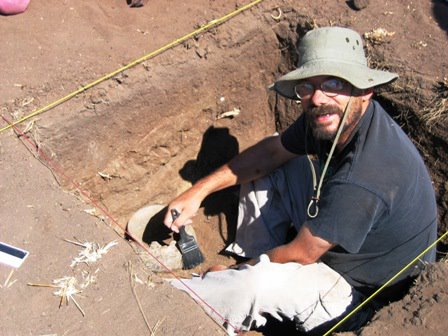No need to re-invent the wheel here, but I want to emphasize a couple of themes running through these posts that the creationists never accept. First, Hawks' comments clearly show that both Afarensis and I were correct in our initial assessments of Bromage's reconstruction - it might be true, but let's see the actual data first. On the other hand (but meeting expectations) the ID crowd willingly followed the scienfically ignorant media lemmings in their rush to condemn paleoanthropology. Turns out, the Bromage reconstruction is not as flawless as the ID crowd would have hoped. It seems the media showed the reconstructed version of the skull at a different angle than Leakey's reconstruction, making it appear to have a much greater (hence, ape-like) slope. When oriented correctly, the slope is somewhat greater, but not sufficiently so to warrant an accusation of fraud on the part of paleoanthropologists. Clearly, reconstructing skulls is difficult work and if Bromage's reconstruction is affirmed by further studies (note to the ID crowd: we do that in actual science) it will demonstrate only one thing to me: that Leakey, without the aid of computerized reconstruction methods, 30+ years ago, pretty much nailed the reconstruction. (Now, if I were to employ the standard "scientific" approach common among the ID folks in its mirror opposite, I would immediately issue a media release stating that the media clearly faked the angle to make the skull appear more apelike because they are, of course, biased against evolution and clearly favor Christian worldviews...I would further claim that the IDists are violating my free speech rights by arguing against my position...and then sniffle with bag of Kleenex in hand as I point out that the "establishment" is just against me and my followers).
There is another thing Hawks points out that was bothering me as well: calculation of 1470's brain size. The ID groupies couldn't help but point out the media reports suggesting that 1470's skull size was smaller with the reconstruction, but that didn't quite mesh, particularly since the whole cranial vault was recovered. Hawks confirmed my own unease regarding the "new" brain size estimation:
There is a lot of talk about the brain size of the specimen. I don't have any details of the presentation, and it is possible that Bromage was incorrectly quoted. Here is what the article says:
The new reconstruction suggests H. rudolfensis' jaw jutted out much farther than previously thought. The researchers say the cranial capacity of a hominid can be estimated based on the angle of the jaw's slope and they have downsized KNM-ER 1470's cranial capacity from 752 cubic centimeters to about 526 cc. (Humans have an average cranial capacity of about 1,300 cc.)
That, of course, is utter nonsense. Ralph Holloway produced an endocast, the joins between the fragments are good, and the volume of 752 cc was measured by water displacement. Why in the world would you estimate brain size from the face when you have a perfectly good vault? It has to be a misquote. [emphasis mine].
Seems the ID proclamation that 1470's brain size is smaller than previously thought is well...(par for the course!)...in error.
Secondly, the very fact that Cordova et al. are so hinging their hopes on a slight change in the angle of the face here, a drop in a few cc's there, and the addition of a minor sagittal crest here and there is due to the 800 pound gorilla that they won't acknowledge standing in the ID/Creationist reading room: these fossils are ALL transitional. We have an extremely difficult time calling one Homo and another Australopithecus, or one Homo erectus and another Homo rudolfensis, precisely because they all share characteristics with each other and none clearly stands out anatomically as separate from the others. Creationists will focus on the ape-like characteristics of one fossil so they can comfortably call it an ape, while completely ignoring its human characteristics. None are distinctly ONLY ape or distinctly ONLY human. And the problem gets more complex every year as more and more hominid fossils are uncovered. I tell my Anthropology 1 students when it comes to reviewing each of the fossil hominids available that they have more to memorize than last year's class (and next year's class will have more to memorize than they do now!).
Finally, Duane's comment on Afarensis' first post cuts to the chase and gets at the heart of why creationists like Sal, Davescot, Casey Luskin and their demi-gods Behe, Dembski and Wells have such a problem with paleoanthropology:
What gets me is that the creationists do absolutely no work. But when there is a suggestion by real scientists that previous work might be in error they jump all over it.
Pretty much describes creationism to a "T"....



